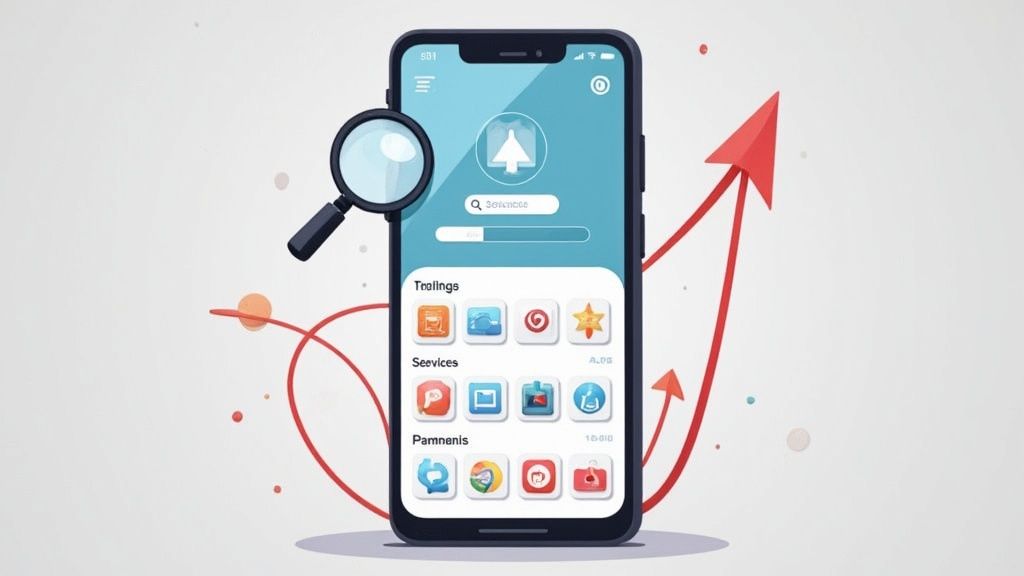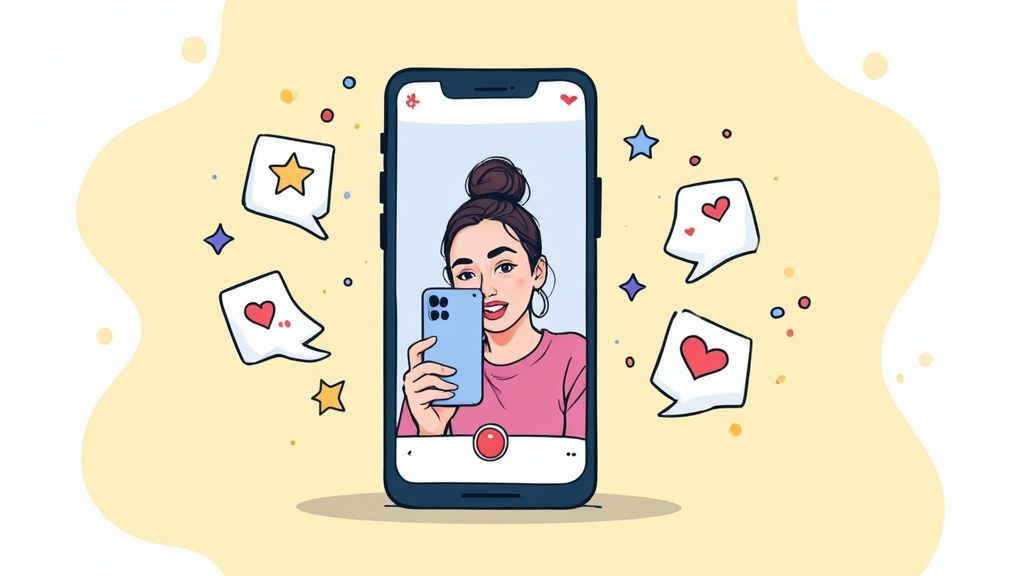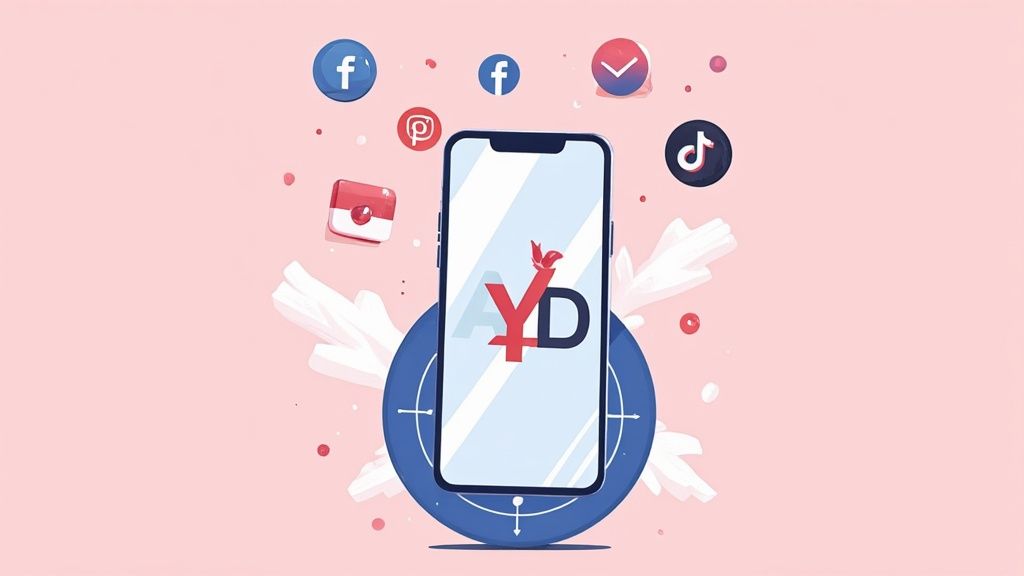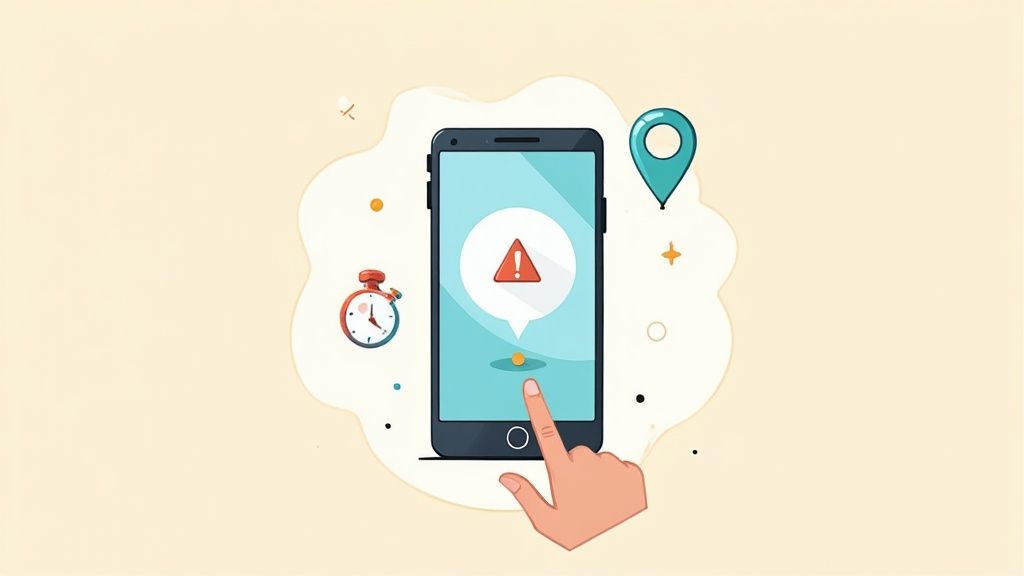Top Mobile App Marketing Strategies to Boost Downloads in 2025
Discover proven mobile app marketing strategies to increase downloads and grow your app’s success in 2025. Learn more now!
Launching a mobile app is a monumental achievement, but it's only the first step. The real challenge lies in cutting through the noise of millions of other apps to capture your target audience's attention, drive consistent downloads, and build a loyal user base. Success does not happen by chance; it is the result of a deliberate, multi-channel approach. A powerful marketing plan is the engine that transforms a great app into a chart-topping success.
This guide provides a comprehensive blueprint of 10 proven mobile app marketing strategies designed to propel your app’s growth. We will move beyond the basics to provide actionable insights you can implement immediately. You will learn how to master everything from App Store Optimization (ASO) and paid social media campaigns to forging strategic influencer partnerships and building effective referral programs.
Throughout this listicle, we will also connect these high-level strategies to a critical, often overlooked, component of conversion: creating efficient and high-converting app store screenshots. For both the iOS App Store and Google Play Store, your visual presentation is your ultimate sales pitch. Let’s dive into the tactics that will turn impressions into downloads and build lasting momentum for your app.
1. App Store Optimization (ASO)
App Store Optimization (ASO) is the foundational mobile app marketing strategy for improving visibility and conversion rates within the Apple App Store and Google Play Store. Think of it as SEO for apps; it involves refining every element of your app store listing, from the title and keywords to the description and user reviews, to rank higher in search results and drive organic downloads. Neglecting ASO means potential users will likely never find your app, no matter how great it is.

While keyword optimization is crucial, your visual assets are the most powerful conversion tool. Your app screenshots are your digital storefront, and they must tell a compelling visual story that grabs attention instantly. Instead of just showing features, highlight the core benefits for the user. A well-designed set of screenshots can dramatically increase app store growth and conversions by showcasing the app's value proposition in a few seconds. For example, using a site editor, you could create a series of vibrant screenshots for a fitness app with bold captions like "Track Your Run," "Crush Your Goals," and "Join a Community" to quickly convey its key benefits.
How to Implement ASO
- Keyword Research: Identify relevant long-tail keywords with high traffic but lower competition. Tools like Sensor Tower can help with this.
- Optimize Visuals: Create on-brand, high-converting screenshots that narrate a clear story: problem, solution, and benefit. You can learn more about designing effective app screenshots to boost performance.
- Encourage Reviews: Prompt satisfied users to leave positive reviews and ratings, as these are significant ranking factors.
- Monitor and Iterate: ASO is not a one-time task. Regularly track your keyword rankings, monitor competitors, and update your listing based on performance data to maintain momentum.
2. Influencer Marketing
Influencer marketing is a powerful mobile app marketing strategy that involves partnering with social media creators and industry experts to promote your app to their dedicated audiences. This approach leverages the trust and authenticity influencers have cultivated with their followers, turning a personal recommendation into a compelling reason to download. By collaborating with the right voices, you can tap into pre-built communities and drive targeted, high-intent traffic directly to your app store page.

This strategy is particularly effective for apps that benefit from visual storytelling and user-generated content. For instance, the language-learning app Duolingo saw a massive surge in downloads by collaborating with TikTok creators to produce viral, entertaining content. Similarly, gaming app Among Us exploded in popularity after being featured by prominent streamers on Twitch and YouTube, showcasing the game's social dynamics to millions of potential players. Authentic promotion from a trusted source can significantly boost app store growth and conversions.
How to Implement Influencer Marketing
- Identify Aligned Influencers: Focus on creators whose audience perfectly matches your target user demographic. Prioritize high engagement rates over sheer follower numbers to ensure the audience is active and receptive.
- Grant Creative Freedom: While providing clear brand guidelines, allow influencers the creative freedom to integrate your app into their content authentically. A forced promotion will feel disingenuous to their audience.
- Track Performance: Use unique promo codes or custom tracking links to measure the campaign's effectiveness. This data is crucial for calculating ROI and refining future mobile app marketing strategies.
- Build Long-Term Partnerships: Instead of one-off campaigns, cultivate lasting relationships with influencers who genuinely love your app. This fosters ongoing advocacy and deeper brand loyalty among their followers.
3. Social Media Advertising
Social media advertising is one of the most powerful mobile app marketing strategies for reaching highly targeted audiences at scale. It involves running paid campaigns on platforms like Meta (Facebook and Instagram), TikTok, and Snapchat to drive app installs and engagement. Unlike organic social media, paid ads leverage sophisticated algorithms and user data to place your app directly in front of the people most likely to download it, making it a direct line to your ideal user base.

The key to success is creating platform-native content that feels less like an ad and more like organic content. For instance, a video ad on TikTok should adopt the platform’s trending formats and sounds. This approach helped the game Genshin Impact achieve massive success with TikTok ads. To justify your investment in social platforms and optimize future spending, it's vital to master Mastering Social Media Marketing ROI from the start. Effective ad creative, often repurposed from your app store screenshots, is essential for stopping the scroll and encouraging clicks.
How to Implement Social Media Advertising
- Define Your Audience: Start with broader targeting settings based on demographics and interests, then narrow them down as you collect performance data to identify your most valuable user segments.
- Create Platform-Native Video: Prioritize short-form video content that looks and feels at home on each specific platform. This authentic approach drives significantly higher engagement.
- Implement Tracking: Set up the Meta Pixel, TikTok Pixel, and other tracking tools to accurately measure installs, in-app events, and campaign effectiveness.
- Test and Retarget: Continuously A/B test ad creatives, formats, and audiences. Set up retargeting campaigns to re-engage users who showed interest but did not convert. You can explore a deeper dive into these and other mobile app marketing trends to stay ahead.
4. Content Marketing
Content marketing is a long-term mobile app marketing strategy focused on creating and distributing valuable, relevant content to attract and engage a target audience. Instead of directly pitching your app, you provide useful information that solves problems or entertains, building trust and authority. This approach positions your brand as a go-to resource, naturally leading users to discover and download your app as the ideal solution to their needs.

This strategy establishes expertise and drives organic traffic that converts over time. For instance, the personal finance app Mint runs a highly successful blog offering financial advice. This content attracts users searching for money management tips, establishes Mint as a credible expert, and seamlessly funnels readers to download their app. Similarly, Canva’s design blog attracts millions of aspiring designers, directly supporting their app’s user acquisition goals by providing immense value upfront.
How to Implement Content Marketing
- Identify User Pain Points: Create content that directly addresses the challenges your target audience faces. A fitness app, for example, could publish articles on "10-minute home workouts" or "healthy meal prep ideas."
- Choose Your Channels: Focus on platforms where your audience is most active, whether it's a blog, a YouTube channel, a podcast, or social media infographics.
- Embed Calls-to-Action (CTAs): Strategically place clear, compelling CTAs within your content that prompt readers to download your app to solve the problem you've discussed.
- Analyze and Repurpose: Use analytics to identify your top-performing content and repurpose it into different formats. A successful blog post can become a video, an infographic, or a series of social media updates to maximize its reach.
5. Referral and Loyalty Programs
Referral and loyalty programs are powerful mobile app marketing strategies that turn your existing user base into an enthusiastic sales force. This approach incentivizes users to invite their network to download your app and rewards them for continued engagement, leveraging the unparalleled power of word-of-mouth recommendations from trusted sources. Instead of spending heavily on ads, you invest in your most valuable asset: your happy customers.
This strategy hinges on creating a viral loop where one user brings in one or more new users, who then do the same. Dropbox famously achieved 3900% growth in 15 months by offering extra storage space for successful referrals. Similarly, Uber and Airbnb built their global empires by giving both the referrer and the new user valuable credits. The key is making the offer irresistible and the sharing process frictionless, which is a cornerstone of modern growth hacking.
How to Implement Referral and Loyalty Programs
- Simplify the Process: Design a simple, one-click sharing process. Make it incredibly easy for users to find their referral link and share it across multiple platforms directly from the app.
- Offer Valuable Rewards: Ensure the incentive is genuinely desirable and aligns with your app’s core function. Cash App’s cash bonus is a perfect example of a reward that reinforces the product's value.
- Promote In-App: Don't hide your program. Promote it visibly within your app's interface, using pop-ups, banners, or a dedicated menu item to keep it top of mind for your users.
- Track and Optimize: Monitor every step of the referral funnel, from invitation to conversion. Use this data to identify friction points and continuously refine your program for better performance.
6. Push Notification Marketing
Push notification marketing is a direct communication channel that allows you to send targeted messages straight to a user's mobile device. This mobile app marketing strategy is exceptionally powerful for re-engaging users, reducing churn, and prompting immediate action. By delivering timely and relevant alerts, you can bring users back into your app, highlight new features, or announce special promotions, effectively keeping your app top-of-mind long after the initial download.
The key to successful push notifications is personalization and value. Generic, intrusive messages will quickly lead users to disable notifications or uninstall your app. Instead, focus on providing genuine utility. For instance, Duolingo famously uses streak reminders to motivate users, which helped increase their daily active users significantly. Similarly, Spotify sends notifications about new releases from favorite artists, driving engagement by delivering highly personalized and welcome content. This direct line of communication is a vital tool for fostering long-term user relationships.
How to Implement Push Notification Marketing
- Segment Your Audience: Group users based on behavior, location, or preferences. Send tailored messages that resonate with each specific segment to maximize relevance and impact.
- Time it Right: Schedule notifications for when your users are most likely to be active and receptive. Avoid sending alerts late at night or during busy work hours.
- Keep it Concise and Actionable: Craft short, compelling messages with a clear call-to-action. Let users know exactly what you want them to do next.
- Test and Optimize: A/B test different message copy, send times, and frequencies to see what drives the best results. Use platforms like OneSignal or Braze to monitor performance and refine your strategy.
7. Email Marketing
Email marketing is a powerful strategy for driving downloads, engagement, and retention by communicating with users outside of the app environment. It involves building a subscriber list and sending targeted campaigns to nurture relationships, announce new features, and bring users back to your app. Unlike many mobile app marketing strategies that fight for attention in a crowded space, email offers a direct and personal line of communication to your audience.
This channel excels at re-engaging lapsed users and keeping your app top-of-mind. For example, the language app Duolingo sends regular "streak reminders" and progress reports, encouraging users to open the app and maintain their learning habits. Similarly, Pocket sends curated "must-read" content emails that drive users directly to articles within the app. These campaigns provide genuine value, strengthening user loyalty and transforming one-time downloads into long-term engagement.
How to Implement Email Marketing
- Build Your List: Collect emails through your website, during the app onboarding process, or by offering valuable content like a free guide.
- Segment Your Audience: Group users based on their behavior, such as new users, power users, or inactive users, to send more relevant and effective campaigns.
- Use Deep Linking: Include clear calls-to-action in your emails that use deep links. These links take users directly to specific screens or content within your app, creating a seamless experience.
- Automate Key Sequences: Set up automated email workflows for onboarding new users, re-engaging those who have become inactive, and celebrating user milestones.
- Optimize for Mobile: Ensure your email designs are fully responsive and look great on mobile devices, as this is where most users will be opening them.
8. Partnership and Cross-Promotion
Partnership and cross-promotion is a powerful mobile app marketing strategy where you collaborate with other non-competing apps or brands to tap into their established audiences. This mutually beneficial approach allows both parties to gain exposure, acquire high-quality users, and enhance brand credibility without a massive ad spend. Instead of building an audience from scratch, you leverage the trust and loyalty another brand has already cultivated.
This strategy works because it introduces your app to a pre-qualified audience. If a user trusts a brand, they are more likely to trust that brand's recommendations. For example, Spotify’s classic partnership with Uber allowed riders to control the music during their trip, creating a seamless and valuable user experience that benefited both apps. This integration felt natural, not forced, which is the key to successful cross-promotion.
How to Implement Partnerships and Cross-Promotion
- Identify Strategic Partners: Look for apps or brands that share a similar target audience but are not direct competitors. A fitness app, for instance, could partner with a healthy meal delivery service.
- Create a Compelling Offer: Propose a collaboration that provides clear, mutual value. This could be co-branded content, a contest, an integrated feature, or a special offer for each other's users.
- Align Brand Messaging: Ensure the promotional materials, including any app store screenshots showcasing the partnership, maintain a consistent voice and visual identity. This reinforces brand trust and clarity for the user.
- Establish and Track KPIs: Define what success looks like from the start. Track key metrics such as referral downloads, user engagement from the partner channel, and conversion rates to measure the partnership's ROI.
9. Public Relations and Media Outreach
Public Relations (PR) and media outreach is a powerful mobile app marketing strategy focused on securing earned media coverage from journalists, bloggers, and industry publications. Unlike paid advertising, PR builds credibility and trust through third-party validation. When a respected outlet like TechCrunch features your app, it acts as a powerful endorsement, driving high-quality organic traffic and boosting your app's reputation in a way that ads cannot replicate. This strategy is crucial for cutting through the noise and establishing your app as a legitimate player.
Effective PR involves more than just sending a press release; it is about storytelling. You need to craft a compelling narrative around your app that goes beyond its features. For example, the audio-chat app Clubhouse generated immense buzz through an exclusivity-driven PR campaign, securing features in major publications by creating a sense of scarcity and high demand. This media hype was instrumental in its initial viral growth, proving that a strong story can be your most valuable marketing asset.
How to Implement Public Relations and Media Outreach
- Develop Your Story Angle: What makes your app newsworthy? Focus on a unique problem it solves, a surprising user trend, or a compelling founder story. Frame it in a way that is relevant to current events or industry trends.
- Build a Targeted Media List: Identify journalists and publications that cover your app's niche. Build relationships with them on social media before you pitch, by engaging with their work authentically.
- Craft a Compelling Pitch: Keep your email pitch short, personalized, and to the point. Explain why your story is a perfect fit for their audience and provide all necessary assets, like a press kit with high-quality screenshots.
- Leverage Media Coverage: Once you secure a feature, promote it across all your marketing channels. Add "As Seen On" logos to your website and app store screenshots to leverage that social proof and boost conversions.
10. Video Marketing and YouTube Advertising
Video marketing is one of the most powerful mobile app marketing strategies for capturing attention and demonstrating your app's value proposition in a dynamic format. It involves creating engaging video content, from short-form ads to in-depth tutorials, and distributing it across platforms like YouTube, TikTok, and Instagram. This strategy leverages visual storytelling to connect with audiences emotionally, making a complex feature or benefit instantly understandable and driving user acquisition.
A well-crafted video can showcase your app's user interface and core functionality in a way static images cannot. It allows potential users to see the app in action, building trust and excitement before they even visit the app store. For example, Headspace uses charming animated videos to explain mindfulness concepts, seamlessly leading viewers to download their app. Similarly, many mobile games use high-energy YouTube ad campaigns to demonstrate gameplay, generating millions of installs by showing users exactly what they will get.
How to Implement Video Marketing
- Hook Viewers Fast: Grab attention within the first 3-5 seconds. Start with a compelling question, a surprising visual, or a clear statement of the problem your app solves.
- Show, Don't Just Tell: Focus on screen recordings and animations of your app in use. You can learn more about creating high-converting mobile app mockups to make your video visuals shine.
- Optimize for Mobile: Design your videos for vertical, sound-off viewing. Use large, clear text overlays and visually-driven narratives that don't rely solely on audio.
- Include a Strong CTA: End every video with a clear call-to-action. Explicitly tell viewers to "Download on the App Store" or "Get it on Google Play" and provide direct links.
Mobile App Marketing Strategies Comparison
| Strategy | Implementation Complexity 🔄 | Resource Requirements ⚡ | Expected Outcomes 📊 | Ideal Use Cases 💡 | Key Advantages ⭐ |
|---|---|---|---|---|---|
| App Store Optimization (ASO) | Medium - ongoing optimization | Moderate - keyword & asset work | Sustainable organic growth, improved conversion | Apps targeting organic discovery and retention | Cost-effective, high-quality organic traffic |
| Influencer Marketing | High - influencer management | High - budget for influencers | Increased awareness, viral potential, engagement | Brand awareness, virality, social proof | Access to engaged audiences, authentic content |
| Social Media Advertising | High - campaign setup & management | High - ad spend & creative assets | Quick user acquisition, measurable ROI | Fast user acquisition, targeted campaigns | Precise targeting, massive reach, real-time control |
| Content Marketing | High - content creation & strategy | Moderate - creation and distribution | Long-term brand authority, SEO, loyal audience | Building brand trust, thought leadership | Builds lasting traffic, cost-effective vs paid ads |
| Referral & Loyalty Programs | High - program design & fraud control | Moderate to High - rewards & tech | Viral growth, improved retention | User acquisition via word-of-mouth | Low CAC, high retention, leverages existing users |
| Push Notification Marketing | Medium - campaign & segmentation | Low to Moderate - platform tools | Increased engagement and retention | User retention and re-engagement | Direct channel, cost-effective, immediate action |
| Email Marketing | Medium - list building & automation | Moderate - email tools and content | High ROI, sustained user communication | Nurturing users outside app | Personalized targeting, automated workflows |
| Partnership & Cross-Promotion | High - negotiation and coordination | Moderate - resource sharing | Access to new audiences, shared growth | Mutual growth with complementary apps/brands | Cost-effective reach, credibility boost |
| Public Relations & Media Outreach | High - relationship building and pitching | Low to Moderate - PR resources | Credibility, brand awareness via earned media | Building trust and third-party validation | Cost-effective, long-term SEO benefits |
| Video Marketing & YouTube Advertising | High - production and editing | High - video creation, ads spend | High engagement, strong conversion via visual content | Demonstrating app features, storytelling | High engagement, viral potential, broad reach |
Build Your Blueprint for Sustainable App Growth
Navigating the competitive app marketplace requires more than just a great product; it demands a strategic, multi-faceted approach to marketing. The journey from initial launch to a top-charting app is built on a foundation of well-executed, interconnected strategies. We have explored a wide array of tactics, from the foundational necessity of App Store Optimization (ASO) to the expansive reach of influencer collaborations and the targeted precision of social media advertising.
The key takeaway is that these mobile app marketing strategies do not operate in a vacuum. A successful public relations campaign drives traffic to your app store page, where powerful ASO and high-converting screenshots must be ready to capitalize on the new attention. Similarly, your content marketing efforts on a blog or YouTube channel should seamlessly guide users toward a download, reinforced by compelling visuals that showcase your app's core value proposition.
Your Path Forward: From Strategy to Action
The most effective marketing plans are dynamic and data-driven. Instead of attempting to implement all ten strategies at once, focus on a phased approach that aligns with your resources and goals.
- Start with the Core: Prioritize a robust ASO strategy. Your app store page is the final conversion point for almost every other marketing channel. Ensure your keywords, title, and especially your screenshots for both the iOS App Store and Google Play Store are meticulously optimized to tell a compelling story and drive downloads.
- Select and Implement: Choose two or three additional strategies that best fit your app and target audience. A visually-driven app might lean into influencer and video marketing, while a B2B productivity tool could find more success with content marketing and targeted email campaigns.
- Measure and Refine: The digital landscape is constantly evolving. Use analytics to track the performance of each channel, from cost per acquisition to user retention rates. Do not be afraid to pivot. If a particular paid ad campaign isn't delivering, reallocate that budget to a referral program that is showing promising organic growth.
Ultimately, building a successful app is a marathon, not a sprint. It involves continuous testing, learning, and refinement. As you grow your user base, remember that acquisition is only one piece of the puzzle. For sustainable growth, understanding how to effectively monetize your application is just as important. Discover various proven app monetization strategies to ensure your hard-earned users contribute to a healthy, long-term business model.
By combining these powerful mobile app marketing strategies with a relentless focus on user value and data-informed decisions, you create a powerful engine for sustainable growth. Your blueprint is now in hand; the next step is to start building.
Ready to create high-converting app store screenshots that amplify every one of your marketing efforts? ScreenshotWhale provides a powerful and intuitive editor to design stunning, professional visuals for the iOS and Android stores in minutes. Stop letting poor visuals undermine your campaigns and start maximizing your conversions today with ScreenshotWhale.